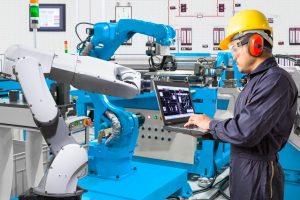It’s estimated that by 2020, more than 1.7 million new industrial robots will be installed in factories around the world; showing that the sales of robotics and automation is on the rise. Currently, the strongest growth in the robotics industry is in Asia; lead by China as the worlds’ number one marketplace.
The North American a utomation market set new records through the first nine months of 2017, according to the Association for Advancing Automation (A3). They found records set in the areas of robotics, machine vision, motion control and motor technology.
utomation market set new records through the first nine months of 2017, according to the Association for Advancing Automation (A3). They found records set in the areas of robotics, machine vision, motion control and motor technology.
According to A3, over 27,000 orders of robots valued at approximately $1.5 billion were sold in North America, which is the highest level ever recording in any other year. These figures represent a growth of 14% in units, and 10% in dollars over the first nine months of 2016. Automotive-related orders were up 11% in units and 10% in dollars, while non-automotive orders are up 20% and 11%, respectively.
Advances in sensors, hydraulics and artificial intelligence are helping to make robots more flexible, precise and autonomous, enabling them to be used in a wider range of manufacturing applications. At Universe Optics we are on the forefront of technology when it comes to designing a precision lens for robotic applications. With ever-changing technology, you can rest assured that UKA delivers lenses crafted to minute specifications guaranteeing the highest quality image for use in multiple forms of robotics and automation.
The marketplace is showing greater investment in robotics and automation. The hottest industries increasing their investments were in metals (54%), automotive components (42%) and food/consumer goods (21%).
There is a trend towards ‘collaborative robots’, smaller and more adaptable machines designed to work alongside the human workforce. It’s forecasted that by 2020, the sales of these machines will have increased tenfold. By improving productivity, automation can sometimes create new jobs, or perhaps relocate them. A new generation of industrial robots will pave the way for even more flexible automation.
A future trend, Industry 4.0 – linking the real-life factory with virtual reality – could play an important role in manufacturing on a global scale. As obstacles like system complexities and data incompatibility are overcome, manufacturers will begin to integrate robots into factory-wide networks of machines and systems.
Analysts are also predicting a rapidly growing market for cloud robotics in which data from one robot is compared to data from others in the same or different locations. The cloud network will allow these connected robots to perform the same activities. This could optimize parameters of the robot’s movement such as speed, angle or force. The advent of big-data in manufacturing could redefine the industry boundaries between equipment makers and manufacturers.
Machines, logistics and production plants are merging into integrated cyber-physical systems. The aim is to use smart factories to work with more flexibility, more cost-efficiently and more productively.
“The market for robotics and automation continues at a healthy growth rate,” said Jeff Burnstein, president of A3. It’s clear that the investments companies are making in these automation technologies is having, and will continue to have, a positive impact on productivity and competitiveness in the global marketplace.